
Old South Church in Boston, Massachusetts, also known as New Old South Church or Third Church, is a historic United Church of Christ congregation first organized in 1669. Its present building was designed in the Gothic Revival style by Charles Amos Cummings and Willard T. Sears, completed in 1873, and amplified by the architects Allen & Collens between 1935–1937. The church, which was built on newly filled land in the Back Bay section of Boston, is located at 645 Boylston Street on Copley Square. It was designated a National Historic Landmark in 1970 for its architectural significance as one of the finest High Victorian Gothic churches in New England. It is home to one of the oldest religious communities in the United States.

The Peter Tufts House is a Colonial American house located in Medford, Massachusetts. It is thought to have been built between 1677 and 1678. Past historians considered it to be the oldest brick house in the United States, although that distinction belongs to Bacon's Castle, the 1665 plantation home of Virginian Arthur Allen. It is also believed to be, possibly, the oldest surviving house in the U.S. with a gambrel roof.

The First Universalist Church is a historic church building on the corner of Pleasant, Elm, and Spring Streets in Auburn, Maine. It was built in 1876 to a design by John Stevens of Boston, Massachusetts, and has been a significant landmark in the city since its construction. It is a fine local example of Gothic Revival architecture executed in brick, and was listed on the National Register of Historic Places in 1979.

The William J. Rotch Gothic Cottage is a historic cottage on 19 Irving Street in New Bedford, Massachusetts. The Gothic Revival cottage was built in 1845 to a design by noted New York City architect Alexander Jackson Davis. It was built for William J. Rotch, a member of one of New Bedford's leading whaling families. It is for these two associations that it was designated a National Historic Landmark in 2006. It is one a very few surviving Gothic cottage designs by Davis, exhibiting features not found in the others that do. The house was included in The Architecture of Country Houses, published in 1850, bringing it early fame and making it an iconic example of the style.

Emmett Cottage is a historic cottage in Brookline, Massachusetts, directly behind Saint Aidan's Church and Rectory. Of uncertain construction date but stylistically dated to the 1840s, it is a little-altered example of a small Gothic Revival cottage. It was listed on the National Register of Historic Places on October 17, 1985.

The Unitarian Universalist Church of Medford and The Osgood House are a historic Unitarian Universalist church building and parsonage house at 141 and 147 High Street in Medford, Massachusetts.

The Common Historic District is a historic district encompassing the civic and institutional heart of Reading, Massachusetts. The district is centered on the town common, at the intersection of Main and Salem Streets. The common has been communally owned since at least 1737, with the original burying ground to the north. In 1769 the area's first meeting house was built, giving the area a sense of identity separate from portions of Reading that would later be set off as Wakefield and North Reading. Since then the area has become a focal point for religious and civic institutions in the town.
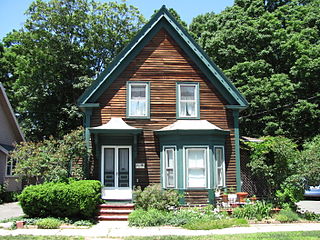
322 Haven Street in Reading, Massachusetts is well preserved cottage with Gothic and Italianate features. Built sometime before 1889, its use of even modest Gothic features is unusual in Reading, where the Gothic Revival was not particularly popular. The house was listed on the National Register of Historic Places in 1984.

The house at 45 Claremont Avenue in Arlington, Massachusetts is a rare local example of transitional Italianate and Gothic Revival styling. Built c. 1885–90, the house has steeply pitched gables and almost Stick style porch decoration that are typical Gothic work, while the house's massing and the bracketed eaves are Italianate. One of its early owners was Theodore B. Merrick, an instructor at the Massachusetts Institute of Technology.
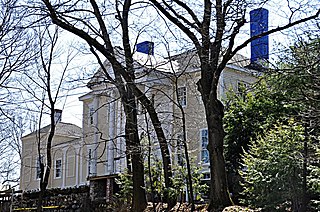
The George P. Fernald House is a historic house at 12 Rock Hill Street in Medford, Massachusetts. The Colonial Revival mansion was built c. 1895 for George P. Fernald, an architect and leading exponent of the Colonial Revival style. The house was probably designed by Fernald, possibly with the assistance of his brother Albert, who was also an architect. The house has a two-story Ionic pedimented portico that shelters an elaborate Federal-style entry, supposedly influenced by Fernald's work making drawings of the Count Rumford Birthplace in Woburn, Massachusetts.
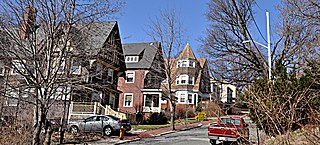
The Hillside Avenue Historic District of Medford, Massachusetts encompasses a well-preserved late 19th-century residential subdivision. It consists of fifteen properties on Hillside and Grand View Avenues, near the downtown area of the city. Most of the houses in the district are Queen Anne Victorians, built in the 1890s; there are a number of Colonial Revival, Tudor, and Shingle style homes, all dating in construction between 1875 and 1895. Of particular note is the Bela Warner house at 35 Hillside Avenue, a dramatically sited Shingle style house built 1881–82.

The John H. McGill House is a historic house at 56 Vernon Street in Medford, Massachusetts. Built in 1902 to a design by local architect Robert Coit, it is one of the city's finest examples of Colonial Revival architecture. It was listed on the National Register of Historic Places in 1980.
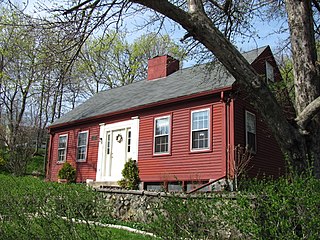
The John Wade House is a historic house located in Medford, Massachusetts. It is locally significant as one of only two surviving early Cape style houses in the city.
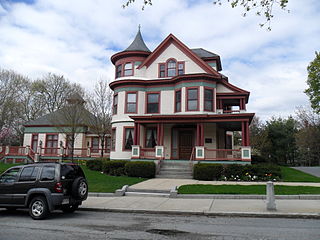
The Woodland Street Historic District is a historic housing district in the Main South area of Worcester, Massachusetts. It consists of 19 Victorian houses that either face or abut on Woodland Street, between Charlotte and Oberlin Streets. The district was listed on the National Register of Historic Places in 1980. Located directly adjacent to the campus of Clark University, some of the buildings are used by Clark for housing and administration.
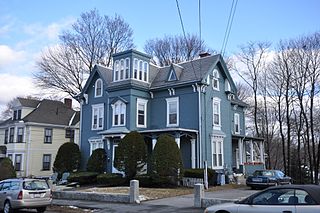
The Charles Wood House is a historic house at 30 Chestnut Street in Stoneham, Massachusetts. It is one of the most elaborate Italianate houses in Stoneham. The 2+1⁄2-story wood-frame house was built c. 1875 for Charles Wood, who lived there until the first decade of the 20th century. Its basic plan is an L shape, but there is a projecting section on the center of the main facade that includes a flat-roof third-story turret, and the roof line has numerous gables facing different directions. There are porches on the front right, and in the crook of the L, with Stick style decorations, the cornice features heavy paired brackets, some of its windows are narrow rounded windows in a somewhat Gothic Revival style, and the walls are clad in several types and shapes of wooden clapboards and shingles.

The T.U. Lyon House is a historic house at 9 Warren Street in Stoneham, Massachusetts. The modest 1+1⁄2-story Greek Revival house was built c. 1850 for T.U. Lyon, a shoe cutter. At the time of its construction Warren Street had been supplanted as the major north–south road through Stoneham by the Medford-Andover Turnpike. Most of its distinctive Greek Revival features, including corner pilasters and a larger-than-typical frieze, have been lost due to recent residing of the exterior.
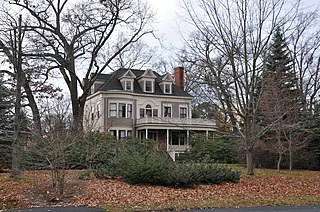
The House at 22 Parker Road is one of a few high style Colonial Revival houses in Wakefield, Massachusetts. The 2+1⁄2-story wood-frame house is estimated to have been built in the 1880s. It has a hip roof, corner pilasters, and gable end dormers, the center one having a swan-neck design. The main facade is divided into three sections: the leftmost has a rounded bay with three windows on each level, and the right section has a Palladian window configuration on the first floor, and a pair of windows on the second. The central section has the front door, sheltered by a porch that wraps around to the right side, flanked by sidelights and topped by a fanlight. Above the front door is a porch door flanked by wide windows and topped by a half-round window with Gothic style insets.

The John A. Fenno House is a historic house at 171 Lowell Avenue in Newton, Massachusetts. The 2+1⁄2-story wood-frame house was built c. 1854, and is a rare local example of Gothic Revival styling. It has an L-shaped plan with steeply gabled roof, diamond windows in the gable ends, and first-floor polygonal bays whose roof lines are bracketed. It was built for John Fenno, who later served as Newton's ninth mayor. When built, it stood at Walnut Street and Madison Avenue; it was moved to this location about 1885.

The Candler Cottage is a historic house at 447 Washington Street in Brookline, Massachusetts. Built about 1850, it is one of the town's few examples of Gothic Revival architecture. It was listed on the National Register of Historic Places in 1985.






















